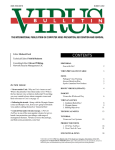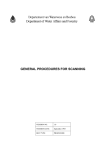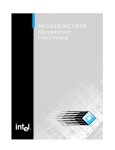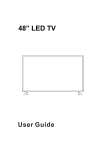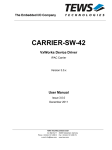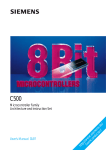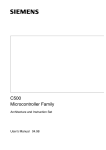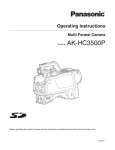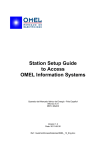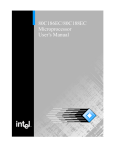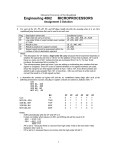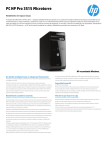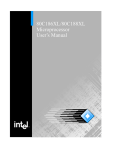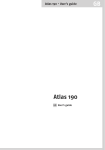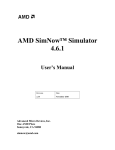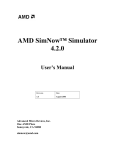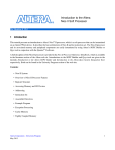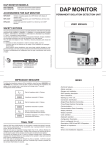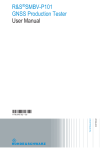Download Engineering 4862 MICROPROCESSORS
Transcript
Memorial University of Newfoundland Engineering 4862 MICROPROCESSORS Assignment 4 Solution Unless otherwise noted, please show all relevant calculations, and explain your answers where appropriate. 0. Write a sequence of instructions (that is, not a full program with TITLE, ASSUME, etc.) that checks whether the memory in a full 64KB segment is functioning correctly. Assume that register AX contains the segment to be checked. Use the string instruction STOSB to load the byte AAH into all 64K locations, and then use LODSB to check that AAH was correctly stored at each of the locations. If the wrong value is read, then call a fictitious subroutine MemError. Otherwise, call Function 4CH of DOS INT 21H to exit. ; Instruction sequence to check 64KB of memory using STOSB and LODSB ; Initialize MOV DS, AX ; Set segments MOV ES, AX CLD ; Set direction flag for increments ; Store 64K byte values to memory MOV DI, 0 ; MOV AL, 0AAh ; MOV CX, 0FFFFh ; REP STOSB ; STOSB ; Set starting offset Set test value Set for 64K-1 locations Store test value Extra store for total of 64KB ; Check that values have been stored correctly MOV SI, 0 ; Set starting offset MOV AH, 0AAh ; Set compare pattern MOV CX, 0 ; Set maximum loops (64KB) Again: LODSB ; Load value from memory CMP AH, AL ; Is value valid? JNE HandleError ; No, there is an error in memory. LOOP Again ; Continue comparing JMP Exit ; All loaded values are valid HandleError: CALL MemError ; Error, call subroutine. Exit: INT 6 Notes: I stated to at least one person that loading register CX with 0 before execution of the REP STOSB instruction would provide for automatically storing to 65536 (64K) locations. However, that is not the case; if you try the above program in DEBUG with CX set to 0, then STOSB will not execute at all. This corroborates the description of REP in the Intel Handbook, which states that REP adds a do while structure to string operation. On the other hand, LOOP functions differently. It first decrements CX, and then checks to see if it is 0. If not, it jumps. Thus if CX is 0, then LOOP will jump 65536 times, as required by the question. In your implementation, you do not need to call INT 6 after you call the subroutine. 1 1. Read Intel 8086/88 User Manual page 6-53 to 6-55: understand how the instruction is encoded to and decoded from machine code. Use the two tables that followed (table 6-22 and 6-23); do the following two questions. Convert the following hexadecimal machine codes to assembly language mnemonics. State what each of the byte fields mean (Table 6-23 from page 6-64 to page 6-69). a. B8 00 20 b. 8E D8 c. 46 d. 90 e. 89 7C FE f. 75 F7 g. E2 EF h. 26 80 07 78 a. B8 00 20 B8 00 20 Answer: b. 8E D8 Answer: MOV SEGREG, REG16 / MEM16 2nd byte: MOD 0 SR R/M 11 0 11 000 MOD = 11 Register Mode SR = 11 Segment register DS (see page 3-57) – operand 1 R/M = 000 Register AX – operand 2 46 Answer: = INC SI INC SI 90 90 Answer: = = MOV DS, AX 46 d. MOV AX, IMMED16 Data-lo Data-hi MOV AX, 2000h 8E D8 c. = = = = NOP NOP 2 e. 89 7C FE 89 7C = = FE = Answer: f. MOV [SI]-2, DI 75 F7 75 F7 = = or JNE –9 JNZ -9 Answer: g. JNE/JNZ short-label IP – INC8 (8-bit signed offset to add to IP) 11110111 2’s complement: 00001001 = 9 Thus the offset is –9 (that is, jump back 9 machine code bytes if not equal) E2 EF E2 EF Answer: h. MOV REG16 / MEM16, REG16 (note error in table 6-23) 2nd byte: MOD REG R/M 01 111 100 MOD = 01 Memory Mode, 8-bit displacement follows REG = 111 DI – operand #2 R/M = 100 (SI) + D8 - operand #1 8-bit signed displacement 11111110 2’s complement: 00000010 = 2 Thus the displacement is –2 = = LOOP short-label IP – INC8 (8-bit signed offset to add to IP) 11101111 2’s complement: 00010001 = 17 Thus the offset is –17 LOOP –17 (loop back 17 machine bytes) 26 80 07 78 26 80 07 = = = 78 = Segment override – ‘ES:’ One of several choices; look at bits 3, 4, & 5 of next byte 00000111 Bits 3, 4, & 5 are ‘000’, so instruction is ADD REG8 / MEM8, IMMED8 MOD = 00 Memory mode, no displacement follows R/M = 111 (BX) 8-bit immediate value Note: instruction must have BYTE PTR to indicate an 8-bit operation Answer: ADD BYTE PTR ES:[BX], 78h 3 2. Convert the following instructions to machine code – give your answers in hexadecimal. State what each of the bit fields mean. i. PUSH BX j. MOV [SI+490], SP k. OUT DX, AL l. POPF m. AND AX, [BX+DI+2Dh] n. ADD DS:[BP], DX Note: you will have to ‘add’ a displacement o. XOR AL, [BX+DI-36H] p. MOV [DI+476], ES a. PUSH BX – two possible answers Memory or Register Operand 11111111 mod 110 r/m mod = 11 r/m = 011 Answer #1: Register Mode (r/m is treated as a “reg” field) Register BX FF F3 Register Operand 01010 reg reg = 011 Answer #2: b. Register BX 53 MOV [SI+490], SP Memory or Register Operand to/from Register Operand 100010 d w mod reg r/m disp-lo disp-hi d=0 w=1 mod = 10 reg = 100 r/m = 100 disp = 1EAh Answer: c. From register Word operands (SP is a 2 byte register) Memory Mode, 16-bit displacement follows Register SP EA = (SI) + D16 Displacement = 490 = 1EAh 89 A4 EA 01 OUT DX, AL Variable Port 1110111w w=0 Answer: Byte operand (AL is a 1 byte register) EE 4 d. POPF 10011101 Answer: e. 9D AND AX, [BX+DI+2Dh] Memory or Register Operand with Register Operand 001000 d w mod reg r/m disp-lo d=1 To register w=1 Word operands (AX is 2 bytes large) mod = 01 Memory Mode, 8-bit displacement follows (2Dh) reg = 000 Register AX r/m = 001 (BX) + (DI) + D8 disp = 2D Displacement is 2Dh, which can fit in a 1 byte signed number Answer: 23 41 2D f. ADD DS:[BP], DX Segment override: It is a bit tricky finding the prefix byte for segment overrides. If you look in Table 6-22 of the Intel User’s Manual, on page 6-61, you will see that the last entry is: SEGMENT=Override prefix 001 reg 110 The reg field is actual a segment register field, and you can use the Segment column of the “reg” Field Bit Assignments chart on page 3-57 to determine how to set it. Segment DS Override: 001 11 110 = 3E Note: you will have to ‘add’ a displacement The addition of a displacement to the memory reference (that is, [BP] ), is needed because there is no encoding for [BP]. Logically, the mod field should be 00, and the r/m field should be 110. But that is a special case, for when a direct address is used (something like [1000h]). To encode, you will have to rewrite the instruction into the functionally equivalent form: ADD DS:[BP+0], DX Memory or Register Operand with Register Operand 000000 d w mod reg r/m disp-lo d=0 w=1 mod = 01 reg = 010 r/m = 110 disp = 00 Answer: g. From register Word operands (DX is 2 bytes large) Memory Mode, 8-bit signed displacement follows Register DX (BP) + D8 Displacement is 0 3E 01 56 00 XOR AL, [BX+DI-36H] Memory or Register Operand with Register Operand 001100 d w mod reg r/m disp-lo d=1 w=0 mod = 01 reg = 000 r/m = 001 disp To register Byte operands (AL is 1 byte large) Memory Mode, 8-bit displacement follows Register AL (BX) + (DI) + D8 Displacement is –36h, which can fit in an 8-bit 2’s complement form 5 36h = 0011 0110b -> (2’s comp) -> 11001010b = CAh = disp Answer: h. 32 41 CA MOV [DI + 476], ES Segment Register to Memory or Register Operand 10001100 mod 0 reg r/m disp-lo disp-hi mod = 10 reg = 00 r/m = 101 disp = 01DC Answer: 3. Memory Mode, 16-bit displacement follows - Note that 476 is too large for an 8-bit signed number! Register ES (note that this is a segment register, and thus is 2 bits large) (DI) + D16 Displacement is 47610 = 1DC16 8C 85 DC 01 The following bytes are found in order somewhere in memory. Assuming they are machine codes, decode the values into meaningful assembly language mnemonics. B9 00 12 D0 C0 E8 C8 E2 F9 B9 – MOV CX, ImmeD16 The next two bytes are the immediate 16-bit value loaded into CX (00 12 -> 1200H) MOV CX, 1200H D0 – One of eight possibilities (ROL, ROR, RCL, etc.), so use the next byte. C0 = 11000000. The first two digit (MSB) “11” is MOD and “11” means that r/m = reg field. The next three digits “000” indicates that ROL Reg8, 1. The last three digits (LSB) is “000”, it is R/M field and represent AL. ROL AL, 1 E8 – CALL Near-proc Indicates that there is a call to a subroutine in the same segment. The next two bytes (IP-INC-Lo and IP-INC-Hi) give a signed 16-bit displacement from the current value of IP. Disp = E2C8 (negative) = 1110001011001000b -> -0001110100111000b = - 1D38H = -7480D CALL [IP-7480] F9 – 4. STC Use full segment definition, write a DOS compatible program that: a) clears the screen, b) set the cursor to screen position row = 10 and column = 5, c) displays the prompt “Please enter an 8-digit number: ”, d) get the keyboard input and save the number to a buffer area in the memory (you define), e) sort the number on its ascending order and save them to another buffer for display. For example, if the input number is 29034765, then after your sort, the result should be 02345679. You can assume that the number for each digit is non-repeat but actually the repeated case is the same, f) after your sort, change to the start of next new line, output “The sorted number is: ” and the number, g) exit use DOS function 4CH. Write task a) and b) using subroutines. Test your code on PC by yourself. ;Tasks: ;(1) Clear the screen use subroutine ;(2) Set the cursor to ROW 10 and COLUMN 5 on the screen use subroutine ;(3) Output a prompt string: "Please enter an 8-digit number:" ;(4) Accept keyboard input: (put to buffer INPUT_BUF) ;(5) Sort the number on its ascending order ;(6) move the sorted number to display buffer (OUTPUT_BUF) ;(7) Change to a new line and Output string: "The sorted number is :" and the number and then exit 6 TITLE Example PAGE 120, 60 ;------------------------------LF EQU 0DH CR EQU 0AH ;------------------------------STSEG SEGMENT DB 64 DUP(?) STSEG ENDS ;------------------------------DTSEG SEGMENT PROMPT1 PROMPT2 DB 'Please enter an 8-digit number:','$' DB LF,CR,'The sorted number is : ',LF,CR,'$' INPUT_BUF LABEL BYTE SIZE_IBUF DB 09H INUMBER DB 00H INPUT_DATA DB 9 DUP(0FFH) DTSEG ENDS ;------------------------------CDSEG SEGMENT MAIN PROC FAR ASSUME CS:CDSEG, DS:DTSEG, SS:STSEG, ES:DTSEG MOV AX, DTSEG MOV DS, AX MOV ES, AX CALL CLEAR CALL CURSOR MOV AH, 09H ;Prompt digit inputs MOV DX, OFFSET PROMPT1 INT 21H MOV AH, 0AH ;get inputs MOV DX, OFFSET INPUT_BUF INT 21H MOV BX, 7 ;sort the number using natural sort method MOV SI, OFFSET INPUT_DATA REP0: MOV DI, SI ADD DI, 1 MOV CX, BX REP1: MOV AL, [SI] MOV AH, [DI] CMP AH, AL JA CONT0 MOV [SI], AH MOV [DI], AL CONT0: INC DI LOOP REP1 INC SI DEC BX JNZ REP0 7 MOV AH, 09H ;send the output prompt MOV DX, OFFSET PROMPT2 INT 21H MOV DX, OFFSET INPUT_DATA ;prepare for the sorted sequence output MOV BX, DX MOV BYTE PTR [BX+8], '$' MOV AH, 09H ;output the sorted sequence INT 21H MOV AH, 4CH INT 21H MAIN ENDP ;--------------------------------CLEAR THE SCREEN CLEAR PROC NEAR MOV AH, 06 MOV AL, 00 MOV BH, 07 MOV CX, 0000 MOV DX, 184FH INT 10H RET CLEAR ENDP ;--------------------------------MOVE CURSOR TO THE POSITION CURSOR PROC NEAR MOV AH, 02 MOV BH, 00 MOV DL, 00 ; columns MOV DH, 00 ; rows INT 10H RET CURSOR ENDP ;-------------------------------CDSEG ENDS END MAIN 8









